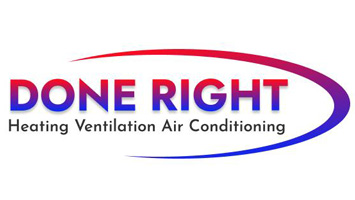
If you’re thinking over air conditioner installation in West Allis & Milwaukee area, you should also be considering your new air conditioner’s SEER rating.
SEER means Seasonal Energy Efficiency Rating. Simply put, it looks at how productive your air conditioner is at turning electricity into cold air. A high number indicates your air conditioner is more efficient, which is excellent for your electric costs.
However, there are many different solutions available for air conditioners. And a higher SEER rating frequently is accompanied by a bigger price. So, how can you find out which one is best for your house?
At Done Right Air, we provide a free, no-pressure home comfort analysis. You can schedule one by contacting us at 414-208-9000. Our knowledgeable air conditioner installers will partner with you to help you pick the right air conditioner for your home. Plus, they’ll also give you a free, no-obligation estimate.
For the time being, let’s review SEER ratings and how they can influence your home’s comfort. And your electrical costs.
Why Do the SEER Ratings Even Matter?
In 2016, the federal government created new SEER criteria. New air conditioners are mandated at least 13 SEER in the northernmost United States and 14 SEER in the southeast and southwest. If you don’t know when you had your air conditioner put in or what its SEER ranking is, you can look at the sticker on the unit outside your residence. If you can’t see the sticker, you can get in touch with us at 414-208-9000 for help.
If your air conditioner was put in in advance of that date, it’s presumably much less efficient. Air conditioner technology has rapidly evolved in the past several years, with big progress in energy efficiency and smart home compatibility. Using your new air conditioner with a smart thermostat could help you conserve more on electric bills, as the thermostat can seamlessly regulate your temperature settings when you’re away.
If your present air conditioner has a SEER rating between 8 and 10, installing a 14-SEER system could save you close to 30–50% on annual air conditioning expenses. Your savings depend on your air conditioner size and your temp settings.
Is the Higher the SEER the Better?
An air conditioner with a better SEER rating will be more efficient at using electricity for cooling. The best efficient systems, which can go as big as 26 SEER, have ENERGY STAR® certification. This designation shows the air conditioner has achieved EPA rules for energy savings and environmental conservation.
While ENERGY STAR air conditioners are frequently more costly, you’ll usually get the difference back over time through smaller utility costs. These air conditioners, which are frequently rated 16 SEER and better, consume about 8% less electricity than other new models, according to ENERGY STAR.
One of the biggest differences between a 14 SEER and 16 SEER is variable-speed technology. A variable-speed air conditioner can cool at a number of speeds. This improves comfort for your house while keeping your electric expenses down. It can also keep temperatures and humidity more consistent, since it can operate for longer without needing a lot more power.
When installing a variable-speed air conditioner, you’ll need to ensure that your furnace or air handler is compatible. This is since your air conditioner uses this system’s blower to send chilled air around your house. Furnaces only last for around 20 years, so if yours is around that age, we recommend furnace installation at the same time so you can get all the perks of your variable-speed air conditioner.
When you’re prepared to replace your air conditioner, the cooling pros at Done Right Air are here to help. Call us at 414-208-9000 to book your free home comfort analysis right away.
